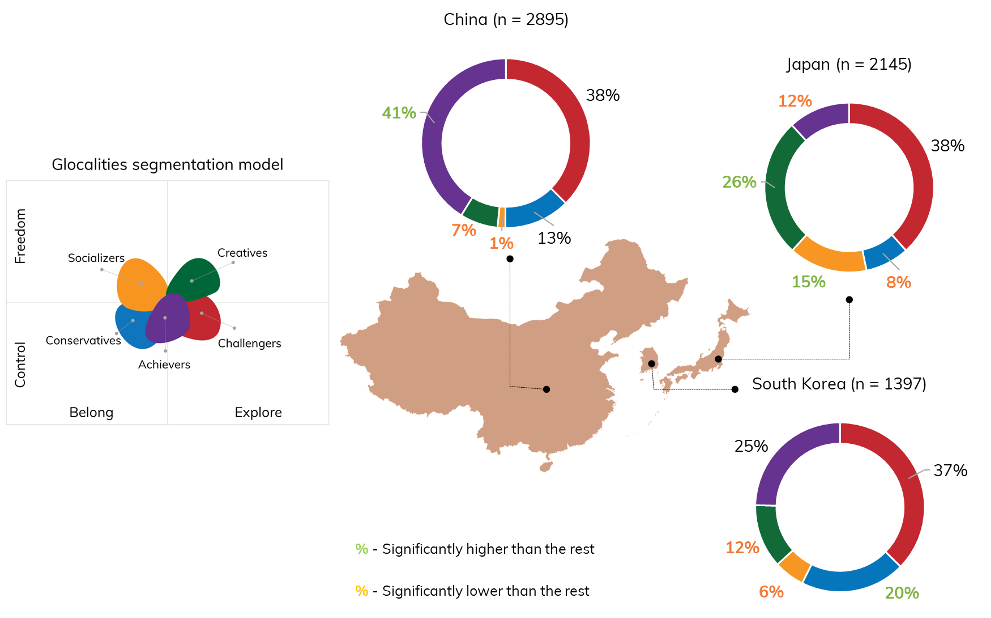The East Asian markets of China, Japan, and South Korea make up to 24% of the world’s economy nowadays. Although they share a common history and culture to a certain extent, the social cultural differences between these markets are significant. By analysing and quantifying these differences between these three markets, international marketeers can adapt their marketing and communication to help build communication that resonates with the local consumers.
Although the general social cultural differences between East Asia and Europe have been studied at length, the differences between the three East Asian markets of China, Japan and Korea are less well analysed and quantified in recent years. Apart from the large differences between these markets, it is also important to note the differences within each market. For instance, the differences between the generations is vast. In many aspects, the generational differences are larger in East Asia than the ones in Western markets.
Figure 1 gives a quick overview of how the values between China, Japan and South Korea differ. It also gives an overview of the similarities and the differences in values structure within each of these three markets.

Source: Glocalities 2019 data
As can be deducted from Figure 1, both China and Japan score very high on the social cultural segments that are more control-orientated (compared to Western cultures). Indeed, 91% of the Chinese population belongs to such social cultural segments. For Japan, this is 58% and South Korea is in between at 82%.
What makes China stand out amongst these three East Asian economies is its vast section of Achievers (41%) – Entrepreneurial networkers who value family and community. This section on society embraces technology as a force for good whole heartedly while at the same time adhering to more traditional family and community value patterns. Historically speaking, Confucianism plays especially in China a predominant role in shaping the value set of this group.
What is also fascinating is that all three markets have approximately similar large amounts of Challengers (37-38%) – Competitive workers with a fascination for money, risk and adventure. Like with Achievers, the Challengers are very much into technology.

Source: Glocalities 2019 data
Techno progression (see figure 2), the belief that technology is a force for good and Early adoption as a social cultural trend also score relatively high in East Asia, particularly in South Korea and China.
The above explains East Asia’s fascination and rapid adoption of new technologies. And this is significantly more so in China and South Korea than in Japan in the past years. This can be seen for instance in the quick adoption of WeChat mobile payment in all businesses in China.
In contrast, the Japanese not only see technology as a force for good but also have more eyes on the negative effects on society of technology. For instance, Pew Research found 83% of Japanese say that the income gap will worsen if automation could do much of the work carried out by humans and that automation leads to job losses.
From a marketing standpoint, it also shows that using technology and progress in general as a tone of voice for communication significantly works better in China. For instance, Bosch uses this technology-oriented tone of voice in its commercial in China to show how its technology ranging from home appliances to driver assistance systems benefit people’s everyday lives:
Furthermore, Japan and South Korea stand out in their relative large sections of Creatives (26% in Japan, 12% in South Korea) – Open-minded idealists who value personal development and culture. This section is hardly existing in China (7%). The social cultural influence of the Creatives on Japan society is visible in its cultural and fashion exports product such the Uniqlo Brand.
It is also interesting to note that in Japan, especially the younger generation, relatively enjoys Changing their looks and Like to be noticed as can be seen among emerging street fashion in the Harajuku district. Cosplay, a Japanese subculture, is also popular among young adults.
China also scores much higher on the social cultural trend of “Embracing foreign goods”. This openness to foreign goods is one of the explanations why it is significantly easier for well-known Western brands to build a customer base in China than in Japan or South Korea. It should be noted that this easiness in building sales does not translate into an easiness of building a viable long-term business as this openness to goods cannot be automatically extended to an openness to building long-term relationships with new foreign partners that you know less well. And it certainly does not mean an openness to foreign values.
By quantifying the social cultural differences between these three mega-markets, international marketeers can tailor their communication more easily in a more fact-based manner. And this approach can also be extended to the social cultural differences within China, Japan and South Korea. For instance, the differences between generations or social cultural value segments. In this manner, marketeers can craft communication strategies that resonates better with their target audience.



1 comment
How can I obtain the data so I can compare different cultures and how they communicate? I am writing a speech for my toastmaster club.